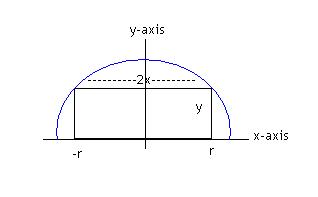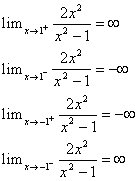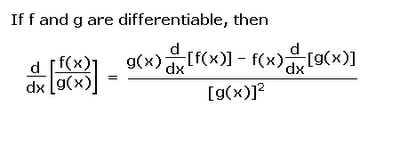The title for Section 4.3 is, in my opinion, quite vague. The concepts, however, are specific, and they clear up a lot of things, such as what derivatives and second derivatives actually mean with respect to a graph's appearance. Let's get started. We'll talk first about, well, first derivatives.
The Increasing/Decreasing Test is another one of those things that's quite simple and easy once you hear it, like the Intermediate Value Theorem. It states that
1) If f ' > 0, then f is increasing, and
2) If f ' <>
This makes perfect sense, because we know that f ' represents the slope of the line tangent to f. So, if the slope of f is positive, the y-values must be increasing as the x values increase, and if the slope is negative, the y-values must be decreasing as the x-values increase.
Now, we have the First Derivative Test, which is pretty self-explanatory. For this test, we must first have c represent a critical point on the function f. Reminder: a critical point is a point on the graph of f where either f '(c) = 0, or f '(c) does not exist.
The First Derivative Test says ...
1) If f ' changes from positive to negative at c, then a local maximum of f is at c.
2) If f ' changes from negative to positive at c, then a local minimum of f is at c.
3) If f ' doesn't change signs at c, then there is no local maximum nor local minimum of f at c.
All right then, let's move on to second derivatives. We know that while the first derivative tells us where a function increases and decreases, the second derivative (the derivative of the first derivative) tells us how the slope of the original function changes.
Before talking about how the second derivative affects a function, we must first define concavity, because, as I’ll explain momentarily, it relates to second derivatives.
On an interval, the graph of f is concave up when its tangents lines lie below the curve,
And the graph of f is concave down when its tangent lines lie above the curve.
That being said, we can use the second derivative to determine where a graph is concave up or concave down. The Concavity Test says …
1) If f ">0, then the graph is concave up.
2) If f "<0,>
As a side note, a point of inflection, a concept we learned in Precalc whose origins were somewhat fuzzy, is a point on a graph f at which the curve changes concavity, or, in other words, where f " changes signs.
The Concavity test leads us to our Second Derivative Test, which states ...
At a critical point c, with f '(c) = 0,
If f "> 0, then a local minimum of f is at c, and
If f "<>f is at c.
Mr. French gives us a helpful and, I must admit, quite fantastic way to remember this. If
f "> 0, or, in other words, if
f" is positive, then it is happy, and makes a Smiley Face. The Mouth of a Smiley Face is concave up, and therefore has a local minimum. Huzzah for pneumonic devices!
EXAMPLE
With the information I just explained, we can easily sketch the graph of a function.
Let's try
y = (x^5) - 5(x^4)
First, find the first a second derivatives.
y' = 5(x^4) - 20(x^3)
y" = 20(x^3) - 60(x^2)
Next, factor the first derivative and find the zeros to find the graph's critical points.
Don't forget to check for place where f ' does not exist. We know there aren't any critical points like that with this function, because it is a polynomial.
y' = 5(x^4) - 20(x^3) = 5(x^3)(x - 4) ==>The critical points are at x=0,4.
Next use either the first or second derivative test to determine whether they are maximums or minumums. Personally, I advocate the second derivative test, as it is much faster and simpler. Plug in the x values to the equation for the second derivative.
y" = 20(x^3) - 60(x^2) = (20(0)^3) - (60(0)^2) = 0. This is neither positive nor negative, so there is neither a maximum nor a minimum.
y" = 20(x^3) - 60(x^2) = (20(4)^3) - (60(4)^2) = 320. This value is positive, so there is a local minimum.
Now, let's plug 0 and 4 into our original equation to find the coordinates. When we do this, we get the coordinates (0,0) and (4, -256).
Next, factor the equation for the second derivative to find the critical points. In the second derivative, the critical points are places where the original function may change concavity, having a point of inflection.
y" = 20(x^3) - 60(x^2) = 20(x^2)(x - 3) ==> The critical points are at x= 0,3. By plugging in values between and outside of those points, we find that before zero, the second derivative is negative, between zero and three, it is still negative, and beyond three, it is positive. Thus, the graph of
y changes from concave down to concave up at x=3. By plugging into the original equation, we find that the specific point of inflection is (3,-162).
Now that we know our points of inflection, the specific local minimum, where the graph is decreasing and increasing, and where it is concave up and concave down, we may sketch the function. Using these new processes, we can break down complicated functions to their essential pieces of behavioral information, and use those essential pieces to sketch.
Here is a website that explains quite well how second derivatives relate to concavity and points of inflection.
John the Prophet, you are now John the Scribe for Lesson 4.4 tomorrow. Don't forget!
Here's some advice that I think we could all do good to hear every once in a while. It comes from the hilarious Douglas Adams.

























































